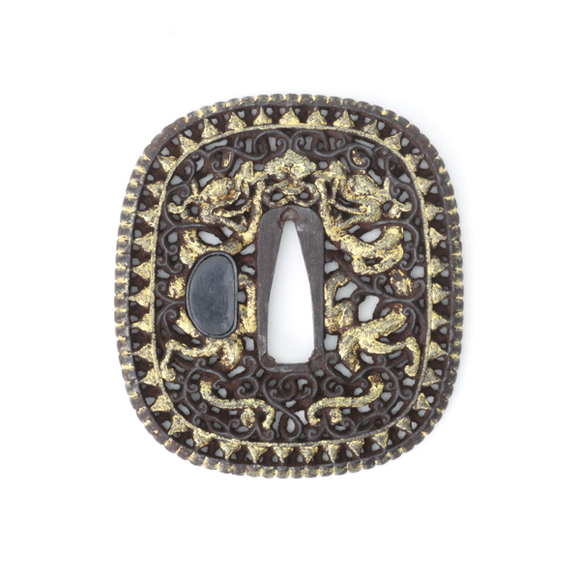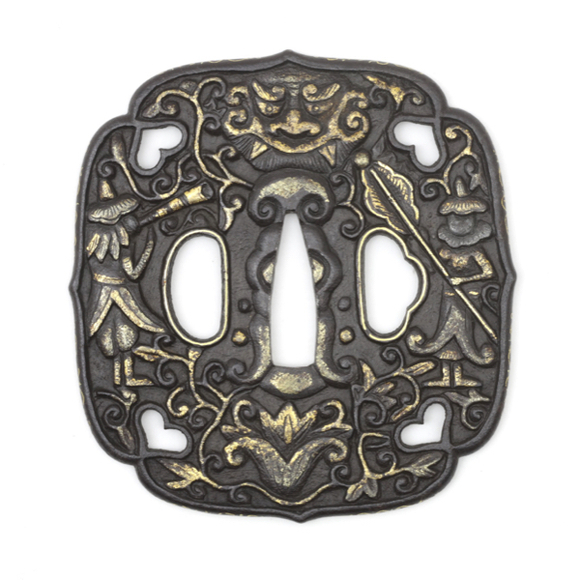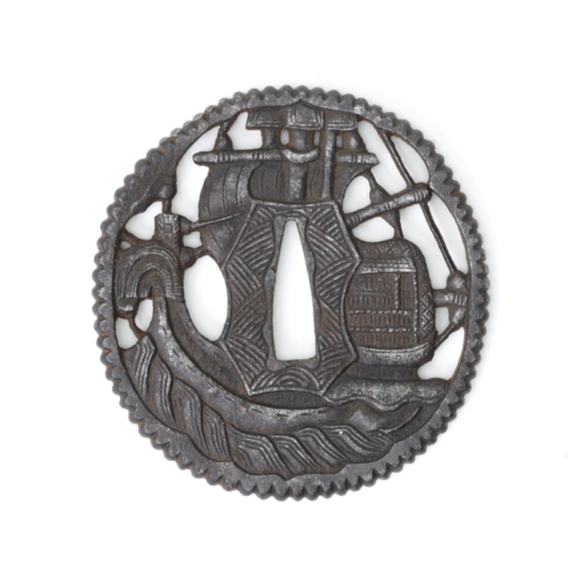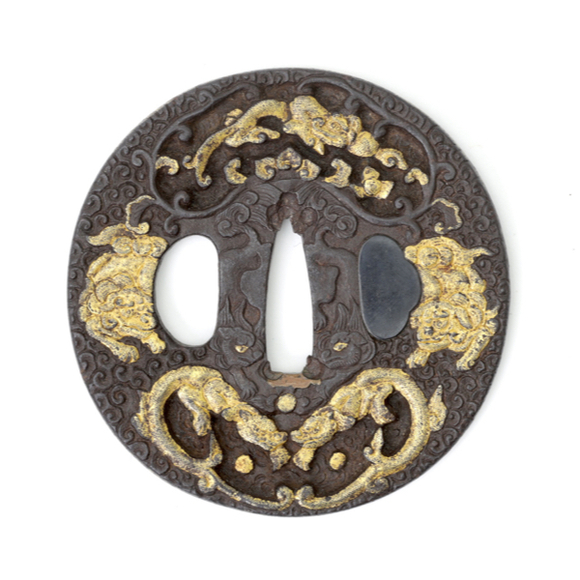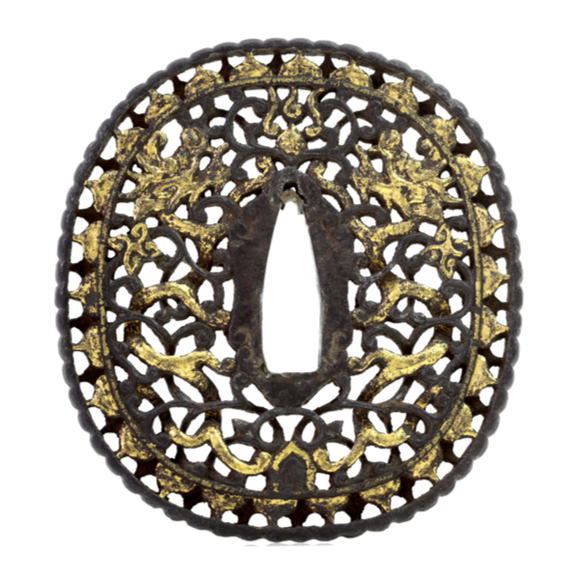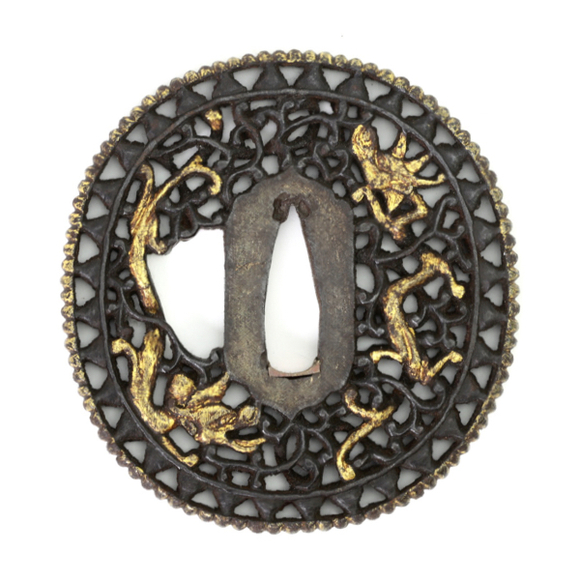Introduction
Among the genre generally classified as Nanban tsuba there is a distinct group with characteristics that point towards Southern Chinese manufacture, most likely its largest port and production center: Canton. These were generally intended for the Japanese market and so "export sword guard" is a more appropriate name.
A genre called "Canton tsuba" has already been described by Boxer, as being sword guards with openwork, undercutting, and exhibiting Chinese and Western designs. Many are decorated with gold overlay.1 The group that fits this description is still quite large and contains many that were made in Japan as well.
With this article, I want to zoom into what I believe is a Chinese-made group that was intended for the Japanese market. They usually have openings (hitsu-ana) incorporated into their designs to accommodate the kogai and kozuka, generally worn in Japanese sword scabbards.
I call it "a Canton group" instead of "the Canton group" because who knows what else they produced there. According to European traders, Cantonese craftsmen could produce almost anything of any quality, if only you paid them for it.
Notes
1. C.R. Boxer; European influence on Japanese fittings 1543-1853. Transactions & Proceedings of the Japan Society, London, Vol 28. Pages 151-178. 1931.
Asian export tsuba, a Canton Group

Some Canton guards
Mandarin Mansion inventory, 2023.
Characteristics of the group
Once you have seen a few of these you will instantly recognize others of the same group. They are always executed in openwork, usually with undercutting, and often with little balls that can freely move inside a small compartment. Also, almost always, they have a beaded rim.
1. Openwork with undercutting.
Usually, the basis of the openwork is a large number of drilled holes, often fairly evenly spaced and still circular in shape. The better quality work is bolder, with less of a "perforated plate" feel.

2. Beaded rim
Almost always, these have beaded rims. Such rims were common on Chinese saber guards from the late 16th century onwards. The stylistic feature became rare in China itself in the 19th century, but may have been continued on pieces that were meant for export to Japan, where 17th-century Chinese guards had been popular.

3. Center plate form
Often these have a center plate with a border consisting of four curved elements with curled ends. These represent clouds or lingzhi mushroom shapes. Such shapes are also seen on the brass guards of standard-pattern Chinese military sabers that were made in Canton. Their quality is a far cry from the export wares produced, because the warrior class by then had fallen into poverty.

Qing military saber of the 19th century.
With mass-produced brass guard.
4. Freely moving balls
Often these have tiny balls that can move freely in small compartments. It is a feature that Cantonese makers took to the extreme in ivory guǐ gōng qiú (鬼工球) or "devil's work balls" that consist of a number of hollow spheres cut from a single block of ivory.

A textbook Canton tsuba with freely moving round iron ball in the top.
5. Gold overlay
The gold application on these is always overlay, where gold was applied cold on a crosshatched background. In Chinese work the crosshatching is almost always done in two directions. On Japanese work, it is almost always done in three directions.
(Of course, it is never straightforward; there are instances of Chinese 3-direction and Japanese 2-direction work.)

Two directional crosshatching on the worn surface of a Canton tsuba.
Dating
Dating is hard, but I suspect most of this work was done in the 18th and 19th centuries. I tend to think that the work that shows a multitude of smaller, rounder, obviously drilled holes generally indicates later work.
Keeping an open mind...
These Asian export sword guards are still much a field of pioneering. Lots of craftsmen were copying each other, and we know of very faithful Japanese-made copies of Chinese work. We deal with a lot of unsigned material, where close inspection of the work itself is our only guidance. Careful study may help us form a more informed opinion than just the off-the-cuff "Nanban" classification thrown at them now.
We're barely scratching the surface, though. Who would have guessed the following was made by a Chinese worker in Nanjing, in the 17th century? Without the signature, I wouldn't:

Chinese sword guard signed:
康煕未歳長楽交造 / 南京寓長楽交造
"Kangxi, year of the sheep. Made by Zhǎng Lèjiāo. / Resident of Nanjing. Made by Zhǎng Lèjiāo."
(Year of manufacture could be 1667, 1679, 1691, 1703 or 1715.)
If it had been left unsigned, it would undoubtedly be classified as Japanese.
Boston Museum of Fine Arts, accession number 19.291
Image © www.mfa.org. Reproduced under fair use.


